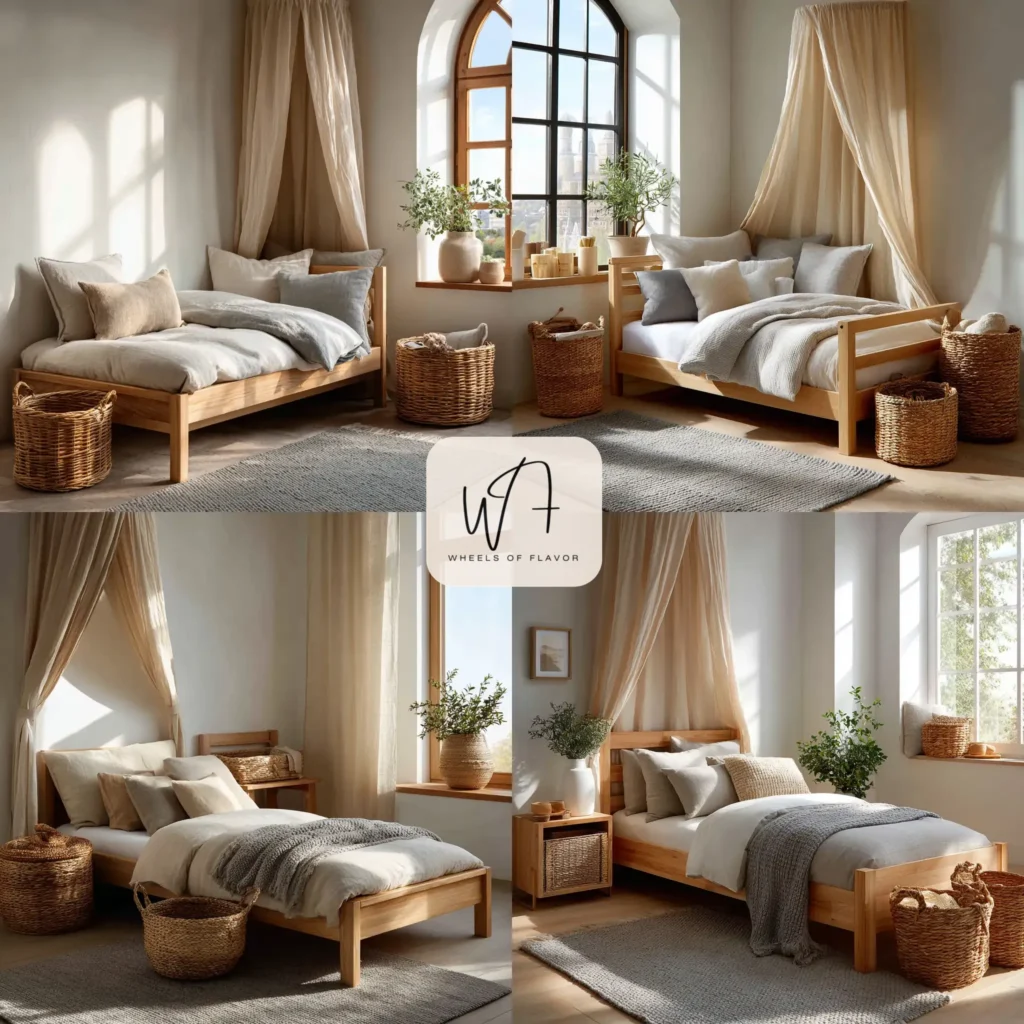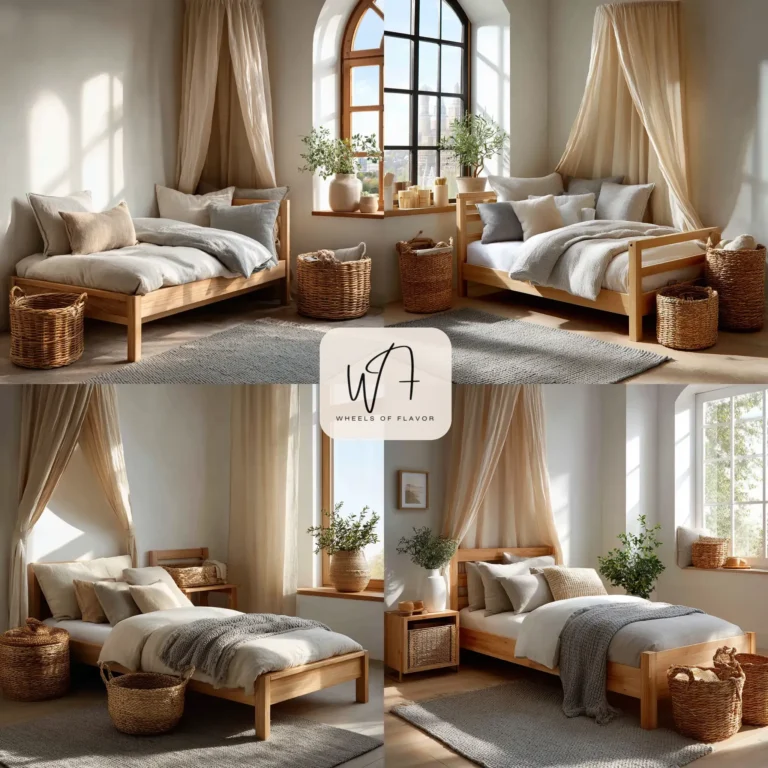Creating a Japandi kids room blends the minimalist elegance of Japanese design with the cozy warmth of Scandinavian style. This aesthetic, known as Japandi, emphasizes simplicity, functionality, and natural elements, making it a perfect choice for crafting a serene and inviting space for children. In this article, we’ll explore three inspiring ideas to design a Japandi kids room that’s both stylish and practical, ensuring a calming environment for your little ones to grow, play, and rest.
Table of Contents
What Is a Japandi Kids Room?
A Japandi kids room combines the clean lines and muted color palettes of Japanese and Scandinavian design to create a space that feels tranquil yet functional. Japandi focuses on natural materials like wood and linen, neutral tones, and uncluttered spaces, which are ideal for fostering creativity and calm in a child’s room. By incorporating soft textures, purposeful furniture, and minimalist decor, this style creates a nurturing environment that appeals to both kids and parents.
This design approach is gaining popularity because it balances aesthetics with practicality. According to a recent article on Architectural Digest, Japandi is one of the top interior design trends for 2025, praised for its timeless appeal and versatility. For kids’ rooms, this style ensures a space that’s easy to maintain while promoting a sense of peace.
Idea 1: Embrace Neutral Tones and Natural Materials
The foundation of a Japandi kids room lies in its color palette and materials. Stick to soft, neutral tones like whites, beiges, grays, and muted pastels to create a calming atmosphere. These colors help reduce visual clutter, making the room feel spacious and serene, which is especially beneficial for young children who can feel overwhelmed by bright, chaotic spaces.
Incorporate natural materials like wood for furniture, such as a low-profile bed frame or a small desk. Bamboo, rattan, and linen are also excellent choices for accents like storage baskets or bedding. For example, a wooden bed with a linen canopy adds warmth and texture without overpowering the space.

To add a playful touch, include subtle patterns like geometric shapes or soft animal motifs on cushions or wall art. These small details keep the room child-friendly while maintaining the Japandi aesthetic. For inspiration on incorporating textures, check out our Styles and Trends section for more minimalist design ideas.
Idea 2: Prioritize Functional and Minimalist Furniture
In a Japandi kids room, furniture should be both functional and aesthetically pleasing. Opt for pieces with clean lines and multi-purpose designs to maximize space and reduce clutter. For instance, a bed with built-in storage drawers or a desk that doubles as a nightstand is ideal for small rooms.
Consider a low-to-the-ground Montessori-style bed, which encourages independence and aligns with the Japandi emphasis on simplicity. Pair it with a small, wooden bookshelf for toys and books, keeping the floor space open for play. The goal is to create a room that feels airy and uncluttered, allowing kids to move freely while keeping essentials within reach.
For additional ideas on space-saving furniture, The Spruce offers practical tips on designing minimalist children’s spaces that align with Japandi principles. By choosing furniture that serves multiple purposes, you’ll create a room that grows with your child.
Idea 3: Add Soft Textures and Thoughtful Decor
To make a Japandi kids room feel cozy and inviting, layer soft textures like wool rugs, cotton throws, and linen curtains. These elements add warmth while maintaining the minimalist aesthetic. A plush rug in a neutral tone can serve as a comfortable play area, while a linen curtain in a soft gray or beige filters natural light beautifully.
Thoughtful decor is key to keeping the room child-friendly yet sophisticated. Instead of overloading the space with toys, choose a few meaningful pieces, like a wooden mobile or handmade wall art. Wall decals with simple nature-inspired designs, such as trees or clouds, can add a playful touch without disrupting the serene vibe.
For decor inspiration, explore our Styles and Trends page to see how minimalism can be adapted for kids’ spaces. Adding a few carefully curated items ensures the room remains functional and visually appealing.
Tips for Maintaining a Japandi Kids Room
Maintaining a Japandi kids room requires a focus on organization and simplicity. Use woven baskets or wooden crates for toy storage to keep clutter at bay. Encourage kids to participate in tidying up by making storage accessible and easy to use. Regularly declutter by donating unused toys or rotating them to keep the space fresh.
Incorporate plants, like a small potted fern or succulent, to bring a touch of nature indoors. These low-maintenance plants align with the Japandi love for organic elements and can teach kids about responsibility. Ensure all decor is safe and age-appropriate, avoiding sharp edges or small items for younger children.
Why Choose a Japandi Kids Room?
A Japandi kids room is more than just a design trend—it’s a lifestyle choice that promotes calm, creativity, and functionality. This style helps children feel secure in a clutter-free environment while giving parents a low-maintenance space that’s easy to clean. By blending Japanese and Scandinavian influences, you create a room that’s both timeless and adaptable, perfect for kids of all ages.
For more insights on creating serene home environments, visit Dwell, which explores how Japandi can transform various spaces in your home.
FAQs About Japandi Kids Rooms
What is a Japandi kids room?
A Japandi kids room combines Japanese and Scandinavian design elements, featuring neutral colors, natural materials, and minimalist furniture to create a serene and functional space for children.
How can I make a Japandi kids room budget-friendly?
Focus on affordable natural materials like wood and linen, shop second-hand for furniture, and limit decor to a few high-impact pieces like wall art or a cozy rug.
Is a Japandi kids room suitable for all ages?
Yes! The minimalist and adaptable nature of Japandi design makes it ideal for babies, toddlers, and older kids, as the room can evolve with their needs.
Where can I find Japandi-inspired furniture for a kids’ room?
Retailers like IKEA, West Elm, and Etsy offer Japandi-style furniture. You can also explore our Styles and Trends page for curated recommendations.

